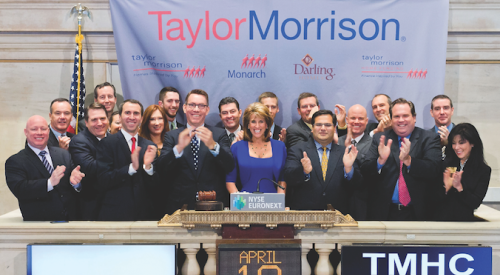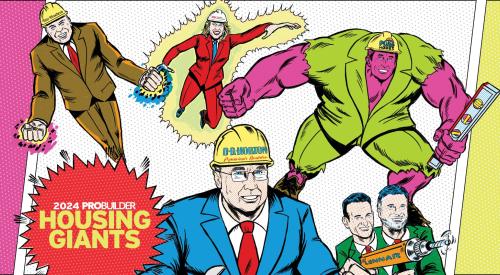There is no stronger indicator of broad-based vitality in home building than this simple fact: of 400 Giants in this year’s 33rd ranking, 64 were not listed last year. Is the bar lower? No, the fewest number of units closed by a Giant is up significantly to 159 from 112 last year. Has the industry become more top heavy? Not really, market share for the Giants remains at traditional levels near 25% and has actually fallen significantly from last year’s large gain. The upshot: In a year when the Giants thrived, there are strong indications that the grass roots of the industry fared at least as well. And the Giants are thriving.
The industry’s largest stick-built producers closed on 462,106 homes in addition to 352,322 units that were sited and closed by the Manufactured Housing Giants - a total of 814,428 homes for the year. It was an increase of 7% on top of a 13% increase from the year before.
A surge in detached, single-family home building, up 15.1% to 314,234 from 272,946, accounted for the preponderance of the unit gain experienced by the largest home builders. But there were also significant gains in townhouse and condominium closings, (51,890), as well as in the number of high-rise, for-sale units, (5808). Construction of low- and high-rise rental units fell slightly to 1809 and 88,365, respectively.
Unit growth was more tepid among the Manufactured Housing Giants. They comprise a separate ranking for a second year on page 104, where detailed analysis of this increasingly important - and more diversified - sector can be found. HUD-code units delivered were up a slight 2.8% to 334,195, while the number of modular 3-D units decreased to 13,980 and panelized units stayed at about the same at 4147.
While unit growth was generally strong, revenue growth was an astonishing 15.5% higher year over year for the group. Giants took in $89.4 billion this time around, up from last year’s record of $77.4 billion. Again the growth can be attributed to the strong market for detached, single-family home building. New residential construction, as a component of overall revenues, grew by more than $12 billion. A portion of the growth is also attributable to revenues from remodeling and non-residential construction, which ballooned to $3.1 billion.
Opportunities and Challenges
There is an increasing sense, however, that the present level of unabated growth will not continue forever. The Fed, in fact, seems determined to slow down rate-sensitive industries like home building as a way to cool the overall economy. As John Stanley, a home building analyst with Warburg Dillon Read puts it, "There is a pretty good chance Mr. Greenspan will be effective in putting on the brakes within the next year or so."
With that in mind, Professional Builder asked respondents to our Giants survey to identify their greatest challenges and opportunities for 2000. As expected, builders have much cause for optimism as well as several areas of concern.
Many Giants view the current strength of the economy as an indicator that things will, for the most part, continue to hum along. Twenty-two percent of the respondents view the "strong economy" as their greatest opportunity in 2000. A greater number, 31%, indicate that an "expanding market" of home buyers would be their greatest opportunity this year. But most respondents, 32.3%, plan to cater to "market niches" as their best chance for continued growth in 2000.
In fact, this year’s ranking is full of companies that are thriving as niche seekers. As PB Senior Editor Bill Lurz points out in the "Movers & Shakers" article on page 113, Spectrum Skanska Inc., Valhalla, N.Y., has offered scaled-down versions of its lifestyle concept to great success. Young professionals in the metropolitan New York area, for example, have responded well to a higher density, detached, single-family Spectrum community north of Manhattan. Spectrum Skanska did not make last year’s list and is ranked No. 98 this year.
Builders that cater to the wealthy are also thriving by catering to what is popularly known as the "wealth effect." A rising stock market has propelled legions of upscale buyers into the home buying scene. Luxury builder Toll Brothers Inc., Huntingdon Valley, Pa., jumps to No. 10 on the list due to its position of prominence in its niche.
But the home building industry is challenging, even in the best of times. Issues that have concerned builders in the past continue to do so in 2000. No-growth advocates, for example, have engendered an atmosphere where government and the overall regulatory apparatus are concerns to 22.6% of the respondents to the Giant questionnaire. Prices for land and its availability are seen as top hurdles for 34.4%. But first and foremost among 37.5% of the respondents are hurdles associated with attracting and keeping people, finding qualified subcontractors, and the rising cost of labor.
The Altering Landscape
As has been the case during the past few years, many Giants have grown through acquisition. Notable in this year’s ranking is the jump made by William Lyon Homes of Newport Beach, Calif. Last year they acquired Newport Beach-based Presley Companies and jumped 75 spots to No. 23 as a result. During the first part of 1999, 11 former Giants were acquired, partly accounting for the large number of companies that are new to the listing this year.
The very top of the industry is changing as well. Not reflected in this year’s listing is the proposed merger between two companies in the top 10 this year - the No. 5 company, Lennar Corp., and the No. 8 company, U.S. Home Corp. If completed this May as expected, the resulting company could assume a leading position in the industry in home building revenue. A pro forma combination would yield a company with $4.9 billion in revenues on 21,658 closings - setting a new benchmark for size.
If not for the current low stock market valuations for home builders, other companies might act upon the inclination to merge as a way of keeping up with the Jones. But it is difficult for companies to agree to be sold for less than book value, which is what U.S. Home Corp. officials did in agreeing to be sold for approximately $36 per share. The issue of low stock valuations for public home building companies is explored in detail on page 128. A return to more reasonable valuations for home building companies in 2000 has the potential of sparking a new round of merger activity.
Aside from the changes to come next year, the top 10 in the Giant 400 is nearly unchanged. Last year’s No. 9 company, Shea Homes, Walnut Creek, Calif., dropped to No. 13, making room for Toll Brothers in the top 10. Meanwhile Kaufman and Broad Home Corp., Los Angeles, surged ahead of Centex Corp. in home building revenue to capture the No. 2 spot. Here’s a closer look at the industry’s pace setters.
-
No.1: Pulte Corp., Bloomfield Hills, Mich., is clearly not a company that is about to rest on its many laurels. In two years the industry’s largest company by number of homes closed and by home building revenue increased its closings by 10,000 units. In terms of unit growth, Pulte has followed its 33% gain of a year ago with a 30.8% gain this year to 26,622 units. Even when merged, Lennar Corp. and U.S. Home will have a hard time putting up numbers like this.
Pulte’s gain of 6000 units was split equally between detached, single-family homes and for-sale townhouses and condominiums. With operations across a wide swath of the country in 24 states, Pulte is equally successful selling to a broad range of buyers—starter 23%; first move-up 33%; second move-up 23%; and retirement 20%.
-
No. 2: Kaufman and Broad Home Corp. for the first time realized the fruits of its December 1998 acquisition of Lewis Homes to the tune of 7000 added closings this year and approximately $1.4 billion in new revenue. The Lewis acquisition also broadened the company geographically and in markets served. Traditionally a builder of homes for first-time buyers, 32 percent of the homes closed by K&B this year were to first and second move-up buyers. The firm is positioned well with divisions in fast-growing communities in Arizona, Nevada and Colorado.
-
No. 3: Centex Corp., Dallas, is the largest company in the home building industry when its core home building revenues are combined with revenues from its related businesses for a total of $5.8 billion this year. Centex added 4500 new detached single-family closings this year and achieved strong unit growth in for-sale condominiums and townhouses. The company builds homes in 19 states and is strongest in Texas, California, Florida and the Mid-Atlantic States.
Top 10 by Housing Type
As in previous years, we highlight those companies that are market leaders in different housing types. -
Single-family detached housing: Kaufman and Broad Home Corp., 22,460 units; D. R. Horton Inc., 17,566; Centex Corp., 17,251; Pulte Corp.,16,014; Lennar Corp., 11,350; The Ryland Group, 9143; Beazer Homes USA, Inc., 7804; U.S. Home Corp., 7515; M. D. C. Holdings Inc., 6895; Del Webb Corp., 6824.
-
Townhouse and condominium housing: Pulte Corp., 10,608 units; NVR Inc., 3074; Heritage Construction Co. Inc., 2024; U.S. Home Corp.,1731; Centex Corp., 1581; D.R. Horton Inc., 1475; Lennar Corp., 1239; Hunt Building Corp., 1081; The Ryland Group, 1050; K. Hovnanian Enterprises Inc., 996.
-
Low-rise rental builders: Trammell Crow Residential, 8426 units; A.G. Spanos Companies, 6918 units; Lincoln Property Co., 5772; JPI Lifestyle Apartment Communities, 4000; Clark Realty Builders LLC, 3521; Colson & Colson Construction Co., 2915; Picerne Real Estate Group, 2500; Camden Property Trust, 2500; Village Green Companies, 2356; Simpson Housing L.P., 1908.
For More Information
The full-format Giant 400 database will be available for sale in a downloadable version on HousingZone.com. It will also be available on floppy disk. For more information call PB at 847/390-2931.












